The past few weeks have felt like a cruel game of emotional tug of war. We are exhausted. It started in Pangai, Tonga, as we prepared to depart for Minerva Reef. It would look like the forecast was lining up for us for several days. We would spend our time feverishly cleaning, preparing passage meals, and planning our route, only to wake up the morning we’d hoped to check out of the country to a vastly different forecast with no departure date in sight. We’d dinghy to shore, buy a six-pack of beer, and sulk around for the afternoon. The cycle would then repeat itself. These are the consequences of our own actions, as now is not the season to sail toward New Zealand. Most boats wait until October/November to make the journey, when the weather is more stable. We knew we were pushing it, but Sabado and crew have been yearning for a break for quite some time now, and we had our sights set on a haul out in New Zealand, where Sabado can get some much-needed TLC, and her crew can enjoy some land life luxuries.
We finally left Pangai on August 22nd, embarking on a bouncy three-day trip to Minerva Reef. Although it was uncomfortable, we made great time. Using our main and jib, we maintained a ~7.5kn SOG, sailing the entire way.
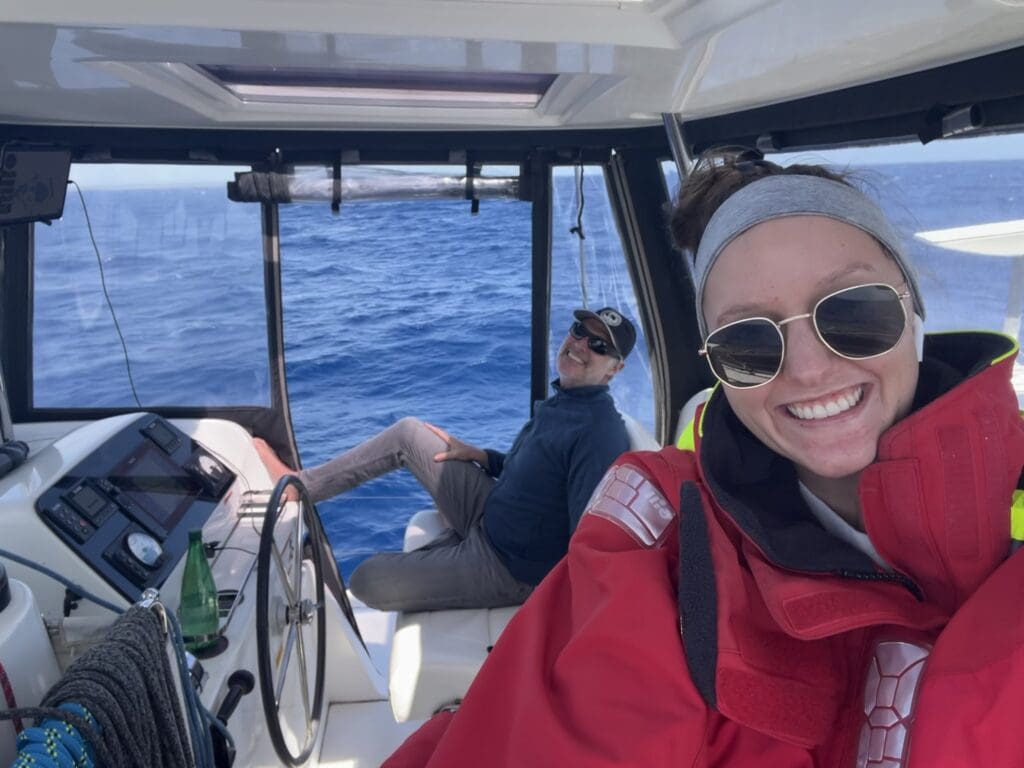
Scanning the horizon with the binoculars while trying to spot the reef as we arrived was fun. This is our first time not being able to shout “land ho!” hours before our arrival; the reefs are nearly invisible at high tide unless the seas are calm or the sun is directly overhead. One moment, we were surrounded by open ocean, and the next, we were slipping through the narrow pass into the atoll, grinning from ear to ear in disbelief! This was definitely a bucket list destination for us. It was surreal to see our location on Google Maps!
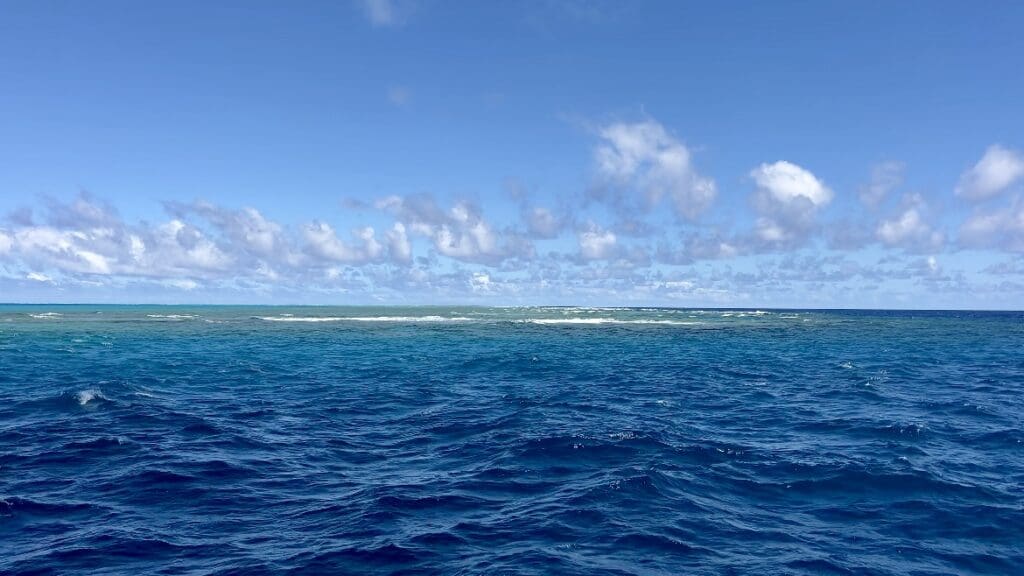
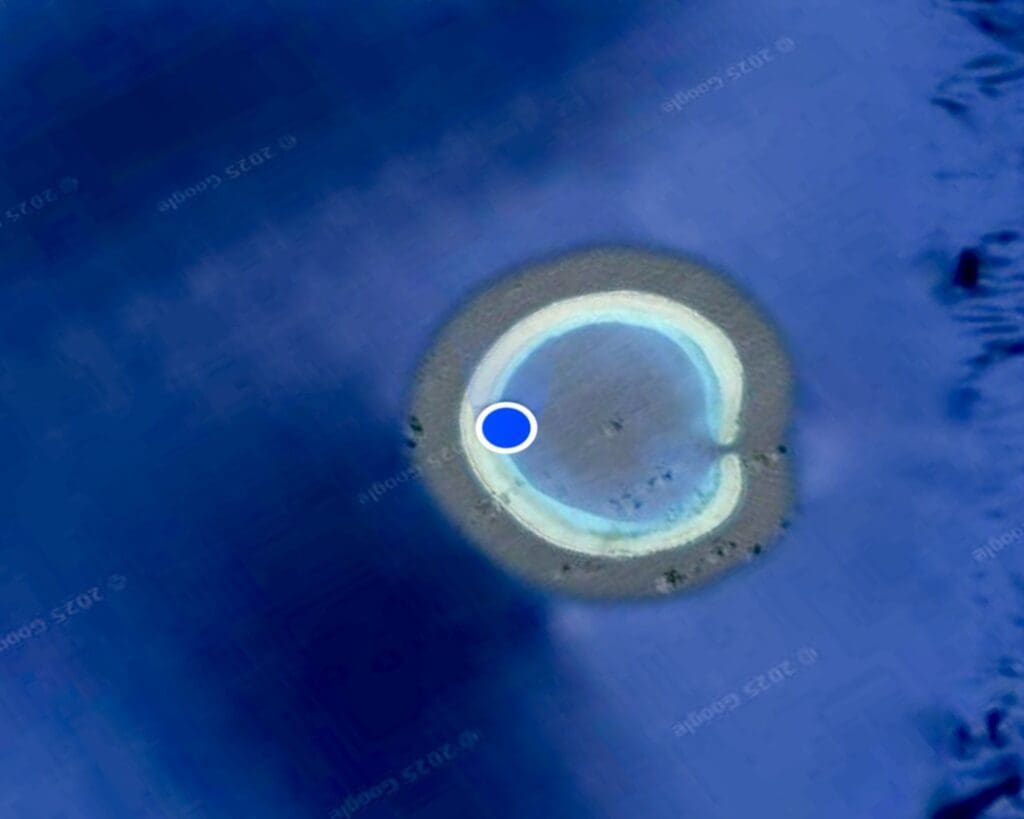
Having the place to ourselves made it feel even more remote, like we’d stumbled onto a secret spot. It was already blowing 20kn as we dropped our anchor, and the wind was set to double, so we used the remaining daylight to put away the sails and prepare Sabado for the incoming storm. We chose to anchor on the southern end of North Minerva Reef, where the reef is more built up, providing maximum protection from the outside swell, but we had scoped out a Plan B spot on the north side to escape the fetch in case the wind clocked around.

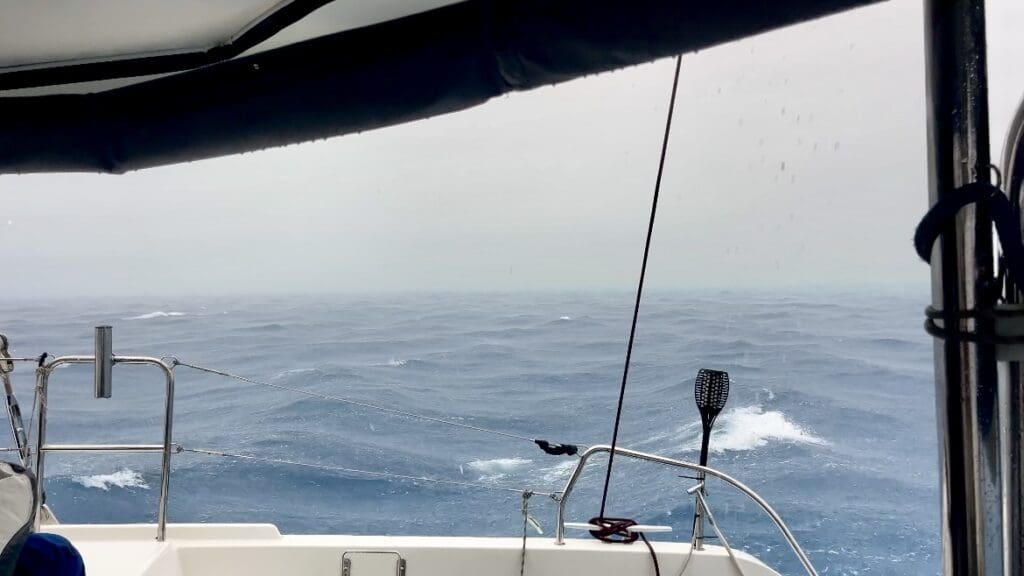
The following 4 days were wet, rough, and gloomy, with wind speeds ranging from 5kn to 50kn. We rotated around our anchor 360° more than once, but luckily, the fetch never became unbearable, so we stayed put on the south side. We did drag at one point, but were able to pull and reset the anchor without issues. There are bommies in Minerva Reef that you cannot see on the satellite images. They are all deep, so they’re not necessarily navigational hazards, but you have to pay close attention when anchoring not to get your chain wrapped around them.
On our fifth day there, we watched our first sunrise over Minerva Reef. The clouds had finally parted, and the winds had ceased. It was unbelievably quiet. There were no palm fronds rustling in the breeze, no cars or dinghy engines running in the distance, no dogs barking or birds chirping, only the sound of waves crashing onto the reef.

We chatted about our plan for the day over coffee, factoring in just how remote we really were. If we were to get injured or ill, help is days away. I often think about Miranda and Elliot’s terrifying medical episode in a remote anchorage in Indonesia. If one of us were to need emergency rescue here, would the other stay and move the boat alone? Not many boats pass through this time of year, so how would we get back if we both left? Mid-discussion, we realized our wind instruments weren’t working. Ray will have to go up the mast. Factoring in our risk analysis, we used every piece of safety equipment we had! 😂
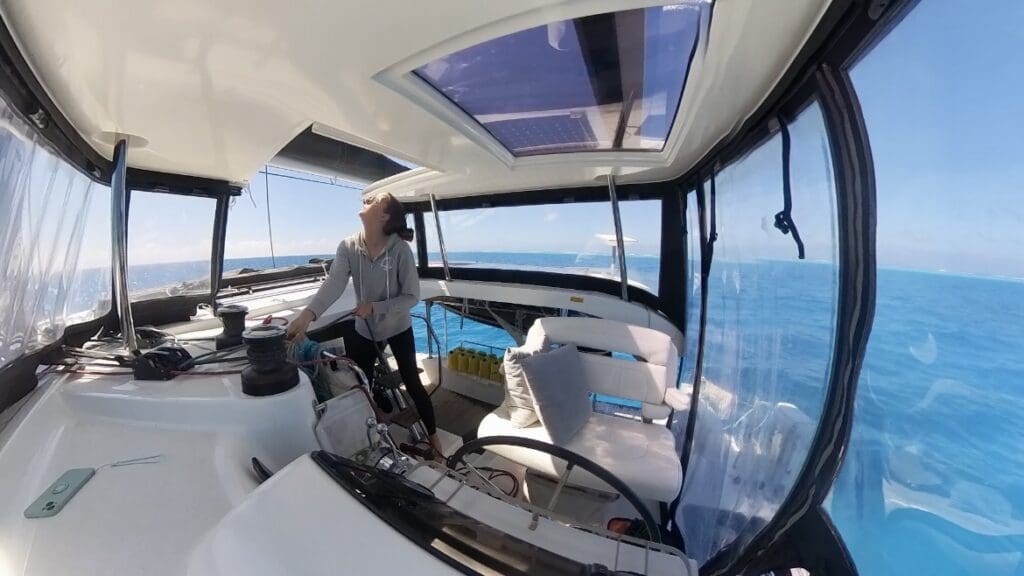

Thankfully, it was a problem we could solve: the bearings in the anemometer had seized up, so it had stopped spinning. Ray dug out our old anemometer that had failed years ago (we keep everything!) and was able to use those bearings as a replacement. I watched in awe as he made the simple swap. I sent him back up the mast, and we had wind data shortly thereafter! Phew! We spent the rest of the day just taking it all in. Minerva Reef is one of those pinch-me places where you feel like a real explorer, anchored in the middle of nowhere with nothing but water, reef, and sky. It’s hard to believe this little atoll has such a wild history, from a multitude of shipwrecks to Tonga and Fiji arguing over who it belongs to, and even a short-lived attempt to turn it into the “Republic of Minerva” back in the ’70s. It’s funny to imagine such drama when it feels so peaceful.
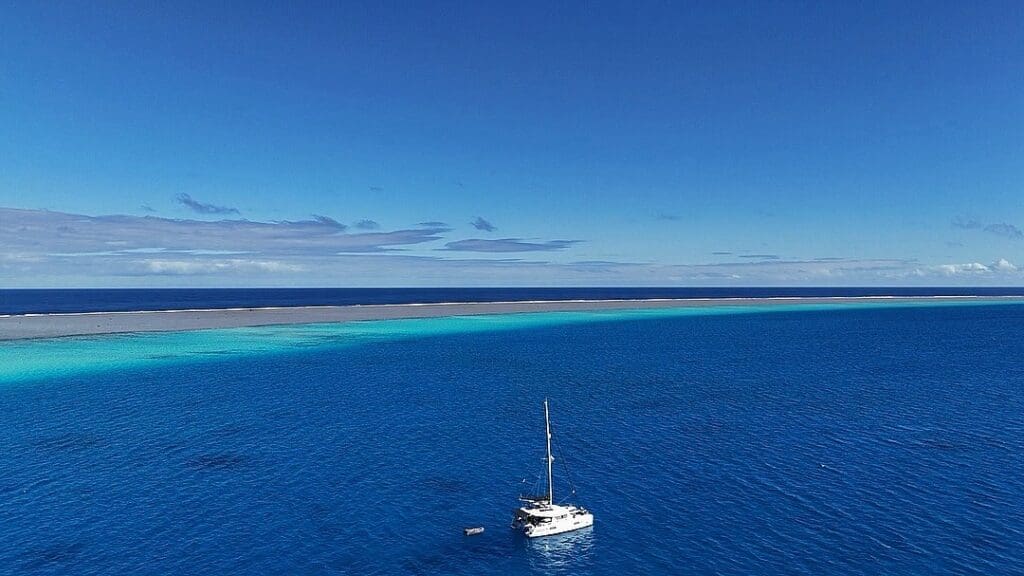
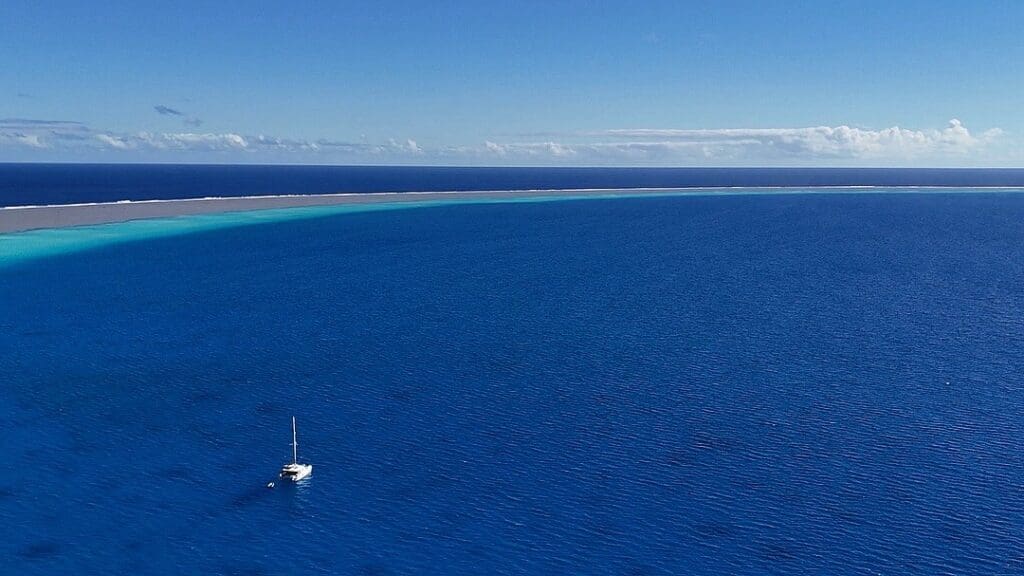
We decided to take the dinghy out at low tide. Here is an excellent guide to exploring Minerva Reef. We were particularly interested in the “walking track” after being boat-bound for the past 7 days. We are very wary of touching/damaging marine life during our travels, but I could not find any resource advising against this. However, we didn’t love the idea of bringing our dinghy up onto the reef like we saw in others’ photos. So, Ray stayed in the dinghy, in the water, while I checked things out.
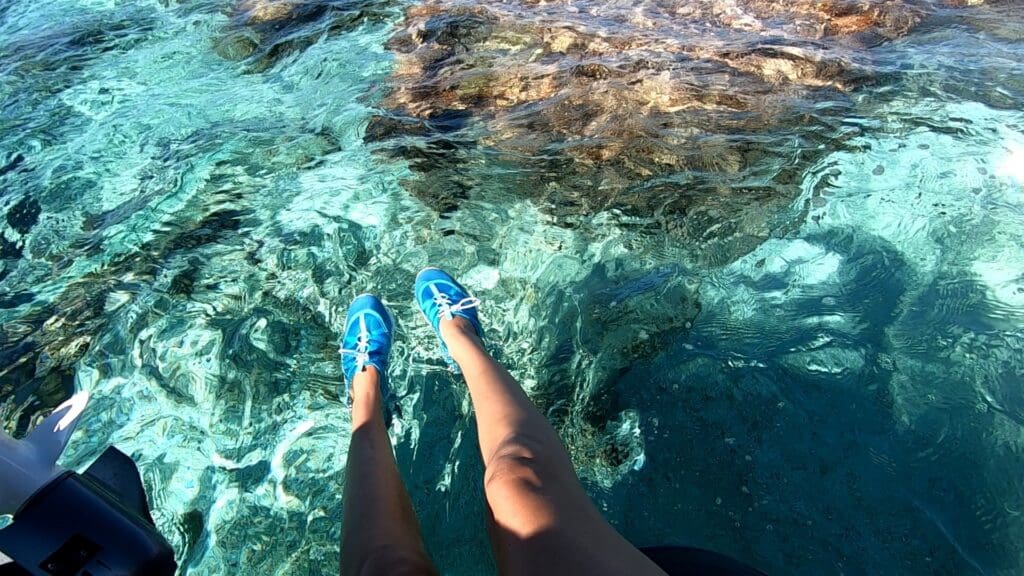
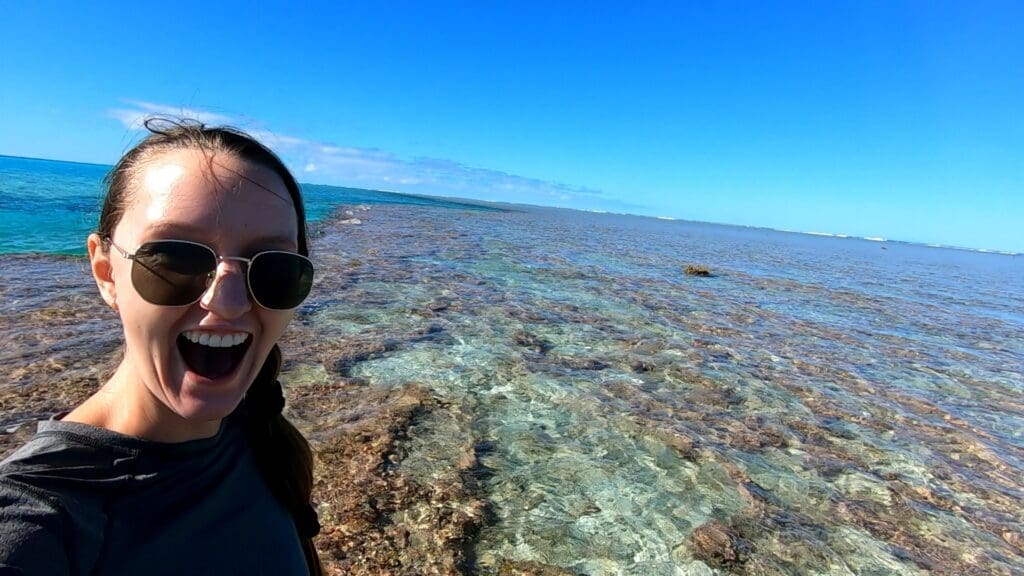

Walking on a reef goes against all my instincts. It felt good to stretch my legs and gently wander through the ankle-deep water, strategically placing my feet where I didn’t see any critters. I cringed at the occasional crunching sensation and quickly decided this didn’t sit right with me. Although I had hoped to walk far enough to look for lobster underneath the rocks in the distance, we had plenty of food on the boat. I made my way back to Ray, and we headed home. I’ve since come to understand that because so few people visit Minerva Reef, the damage of a few footprints is insignificant. The reef has historically been able to bounce back effortlessly. I guess I’m just a bit sensitive. 😉
The next weather update gave us the green light to leave in two days. We spent the evening reviewing our paperwork for New Zealand, planning our route, and taking a break to watch a beautiful sunset over the Pacific Ocean.

We were grateful we had begun preparations when, the following morning, our weather router encouraged us to leave ASAP to give us ample time to arrive ahead of a storm. We pulled anchor that afternoon and began the last leg of our long-awaited passage to New Zealand.
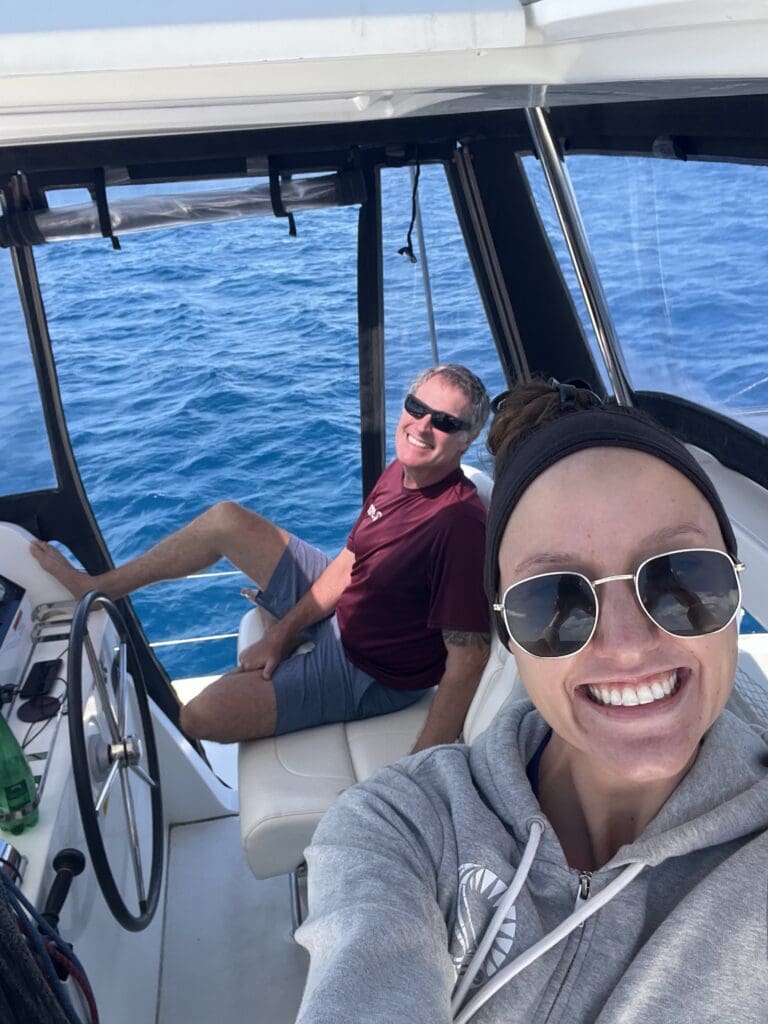
The first two days were miserable. Although we made great time on day 1, averaging SOG 7.3kn, the wind came from a different angle than anticipated. Then, we had a dramatic forecast change overnight that doubled the sea state. We found ourselves slogging upwind, bashing into 10-foot waves, all while getting messages from our weather router about how important it was to maintain our speed. The storm we were trying to beat kept getting closer and closer… what started as “you must arrive in New Zealand by Monday” became Sunday, then Saturday… I hadn’t felt seasick in years, but these conditions had me clamoring around our medicine cabinet in search of Dramamine.
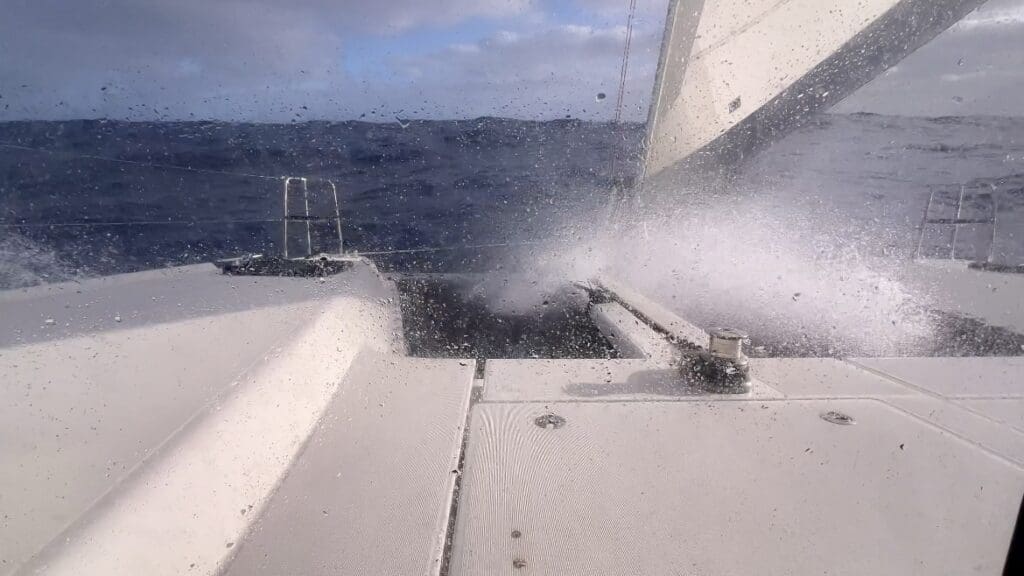
Thankfully, the sea state began to subside after night 2 as the wind died, but we quickly found ourselves facing a new challenge: no wind and a strong countercurrent. Even with both engines set to 2200 RPM, we struggled to maintain SOG 5kn. The incoming storm was beginning to look quite dangerous, with our weather router estimating 70kn winds and 8m seas upon our arrival. We needed to go faster.
The updated forecast showed no wind for the next 4 days. We didn’t have enough fuel to keep running both engines like this, so we weighed our options:
- We could alter course and motor ~12hrs to try to get out of the current, but the amount of fuel and time it would take, not making headway toward our destination, was risky.
- We could turn around, but the storm would likely still catch us. Perhaps it would be weaker by then. I submitted several inquiries at haul-out facilities in Fiji, just in case. If we endured all this only to turn around, we would need a break from boat life before trying again.
- We could head to Australia instead, adding nearly two weeks to this passage but potentially putting us out of the storm’s path in time. Did we have enough provisions to turn a week-long passage into a three-week passage?
- We could pray/manifest/trust that the wind would fill out and we could hoist our sails and boost our speed, and/or that the current would dissipate soon.
There was no perfect choice. Despite making it this far, it felt like our New Zealand dream might not become a reality, again! Amidst all this, we noticed the halyard had wrapped around the forestay. We’d dropped the sail when the wind died overnight, and although things had mellowed out, it was not calm. The motion must’ve caused the halyard to swing enough to get tangled; we should have secured it better.
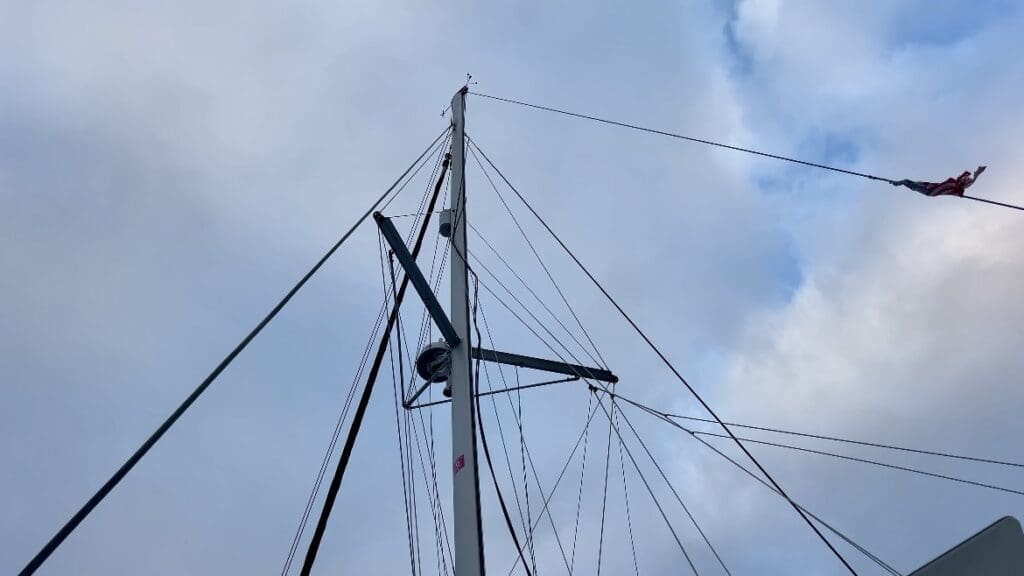
We tried flinging the line around to knock it loose, but could only free one side. Ray would need to go up the mast, underway, using only one side of the halyard. We had to Google the knot we needed: the Alpine Butterfly Knot. Admittedly, having to look this up did not inspire much confidence in our plan. The icing on the cake: the batteries for our headsets weren’t holding a charge, so our ability to communicate was severely restricted. We took a deep breath and got on with it, because, well, we had to! I got Ray up the mast, and he untangled the halyard. I brought him back down to safety with only a few bruises as Sabado dove over waves, knocking him around quite a bit.
He took some Advil, and we had a brief moment of celebration before revisiting the decision at hand: to turn around, alter course, or proceed. We were cold, tired, stressed, and frustrated with the unreliable forecast. We had two paid weather experts and a friend who is a meteorologist helping us, and we still found ourselves in this mess! If you’re reading this, don’t try to make this trip early. We’ve learned our lesson! We decided to wait until noon tomorrow to make a decision. The forecast had been wrong every day so far, so who’s to say we won’t get enough wind to hoist the sails again, which might boost our speed enough to make a Saturday arrival ahead of the storm. We had come so far, we decided it was worth a shot.
That afternoon, I received an email from New Zealand MPI requesting information regarding our arrival and antifoul/cleanliness of hulls. New Zealand has a reputation for having some of the strictest biosecurity rules in the world when it comes to clearing in yachts. Officials are very thorough about preventing pests, diseases, and invasive species from entering their ecosystem, so arriving boats are inspected carefully, inside and out. I had prepared a 6-page report in anticipation of this, which included recent ports, notes from past hull cleanings, receipts from haul-outs when antifoul was applied, etc. I wasn’t aware I’d be asked to submit this prior to our arrival, but apparently, this “pre-clearance” procedure is new and is meant to help streamline the process upon arrival. So, I submitted my report, which was promptly denied. They provided two reasons for rejecting my report: 1) I did not include enough photos/my photos were missing areas of the boat, and 2) the photos were too dark and not of high enough quality. Given the sea state and time crunch we were under, I opted not to get in the water to gather more evidence to submit. The denial email said they could re-assess us on arrival, since the evidence was the problem, not necessarily the actual cleanliness of our hull. After this exchange, I also randomly received several other emails from New Zealand government officials, responding to inquiries I had made nearly a year ago about visa requirements. Their system must have pinged our boat name or email address after we submitted our Advanced Notice of Arrival. It wasn’t a big deal; it was just a bit overwhelming and confusing while underway, since they had already responded to all my inquiries when I had first sent them months ago.
We’d been keeping an eye on our fuel level and began questioning its accuracy… the last thing we wanted to do was miscalculate based on an inaccurate reading and not have enough fuel to make it up the inlet to the Quarantine Dock, especially if we were going to arrive in bad weather. Ray took apart our bed to get a visual on one of the tanks. Thankfully, it looked like it aligned with the level our system was reporting. Simultaneously, we got another message from our weather router encouraging us to turn around. We went back and forth with our decision, ultimately choosing to continue. Given our decision, we were advised to aim for the northernmost tip of New Zealand, allowing us to keep the strongest wind/seas more behind us as we approach ahead of the front. Then, if we are still underway as the front passes on Saturday, we’d be more protected along the immediate East Coast as we move toward our intended destination.
By nothing short of a miracle, the wind began to pick up, and the current we’d been battling disappeared. We hoisted the sails, still using one engine to boost our speed, but feeling optimistic about cutting our fuel consumption in half. Our SOG bounced between 6kn and 8.5kn, and we watched our ETA slip out of the danger zone. We were still cutting it close, so watch shifts were very active. The wind speed and direction fluctuated constantly, so we stayed sharp, frequently adjusting our sails, engine RPM, and heading to maximize Velocity Made Good and minimize fuel consumption. Usually, even on challenging passages, there are pockets of peace where we can kick back and appreciate our surroundings, often marveling at how amazing this life is and how lucky we are to be out here, but this passage was stressful the entire time. It was a whirlwind of discomfort: enduring bone-chilling temperatures at the helm overnight, battling difficult and rapidly changing conditions, and wrestling with the constant underlying fear that we were making the wrong decision.
Thankfully, we were able to keep our speed up for the next 48 hours. Conditions got a bit sporty toward the end, but we escaped the worst of the storm as we headed up the inlet toward Bay of Islands Marina.
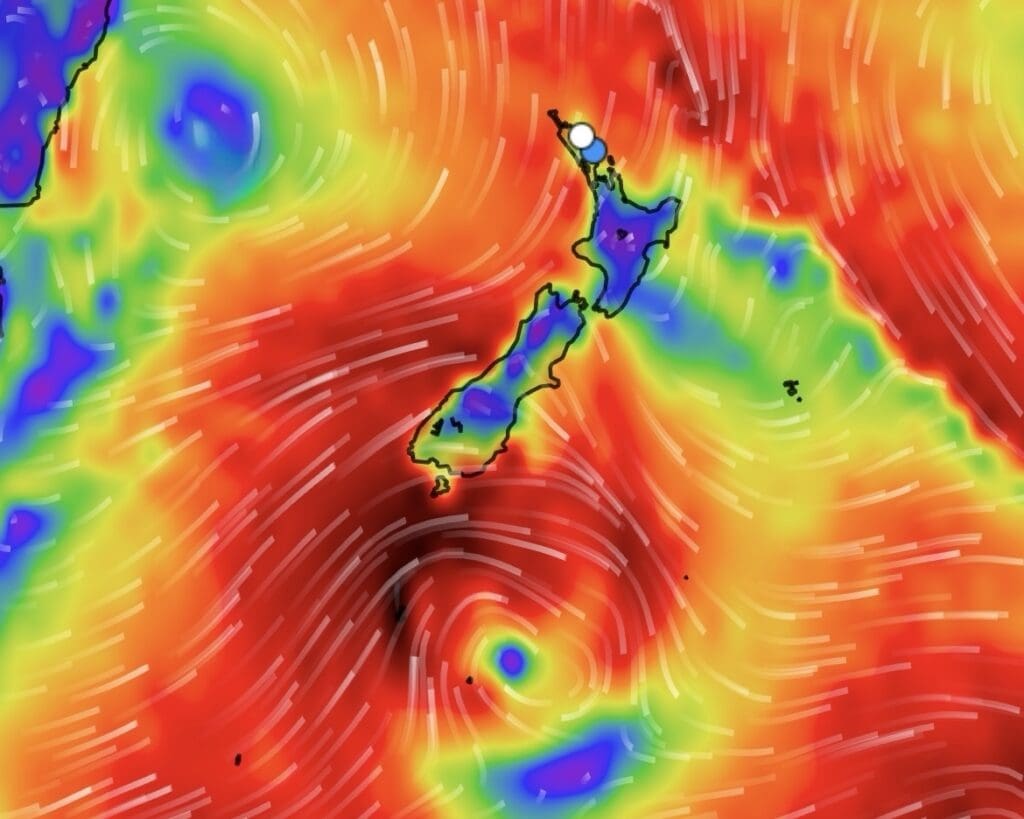
We arrived at the Quarantine Dock a few hours before sunrise on Saturday morning. It was pouring rain, the dock did not have any lights, and we were surprised to see nearly 5kn of current ripping through the channel. We tried to get the stern close enough to the dock so that I could step off and secure a line onto the cleat, but we couldn’t maneuver properly against the current, so we kept trying. I was shivering, holding a flashlight in one hand, a fender in the other, and balancing a soaking wet dock line over my shoulder. This is an actual quarantine dock: it is only accessible by boat, and we were the only boat there, so no one was coming to help us. Ray got me close enough to step off, and I immediately locked the stern line into place. From there, he brought the bow in and tossed me the bowline. Holy smokes, we did it!
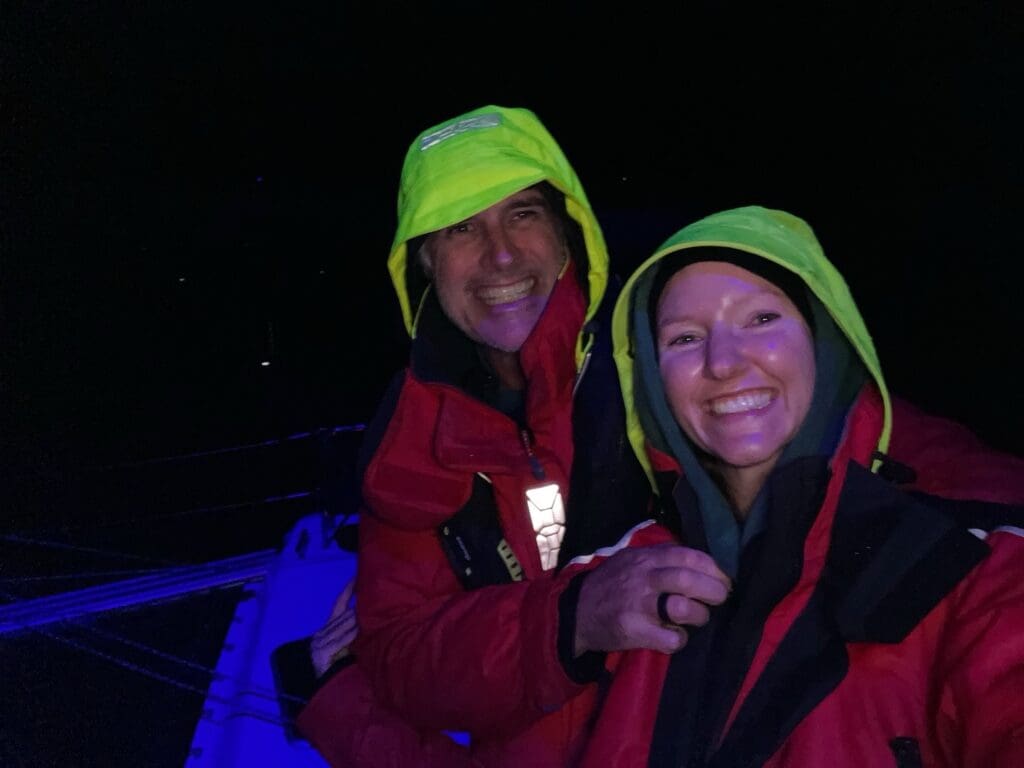
Hot showers were the first order of business, followed by a quick tidy of the boat, as the customs/immigration and MPI officials would be boarding shortly, and we had salt-soaked clothes, towels, and blankets everywhere. We had enough time to defrost our fingers and toes and drink some coffee before they arrived by dinghy. The check-in process took 4 hours and is the strictest we have ever experienced. I’m working on a detailed blog post that will hopefully help streamline things for any of you heading this way, so please keep an eye out for that post. There was some confusion as the MPI officer gave us full biosecurity clearance upon reassessing the photos of the hull in person, but then returned to the boat several hours later to amend our status, hand writing on the form that future direction was needed, urging us to haul out as soon as possible, but clarifying that the growth on our hull was “within the threshold” and we were not required to complete the biofouling haulout within 24hrs of our arrival (which is the usual consequence if you are not granted full clearance).
We had hoped to chill in the marina for a week to rest and recover. The boat needed a deep clean, we desperately needed to do laundry as we each only own two pairs of pants and we’d been wearing them both under our foulies to keep warm for the past week, plus we didn’t have enough fuel to make it to a fuel dock so we’d need to sort out a car and transport jerry jugs, etc. But we felt uneasy about the revised biosecurity classification. If they saw anything on our hull that was even mildly concerning, we wanted to be certain we were doing our part to protect the local ecosystem. So, we decided to shorten our marina visit to two nights, giving us enough time to catch up on sleep and refuel the boat; we figured we could tackle the rest of our to-do list after we hauled out. The marina offered a courtesy car, so we were able to transport our jerry jugs back and forth to the gas station on Sunday and depart the marina on Monday for an overnight motor to Port Whangarei Marine Center. It was far rougher than what was forecasted, I know, shocker!!! But the end was in sight at this point, so we pressed onward and pulled into the haul-out slip just after sunrise. The guys at Port Whangarei Marine Center were armed with lines and fenders, ready to assist us. Ray maneuvered Sabado into the well, and the yard guys positioned the straps for the travel lift without a single fender even touching the dock. The next thing we knew, Sabado was hovering above ground.

We rented a car and have begun moving into a rental home. We plan to take everything off the boat before we start our lengthy refit project list. We know it’s going to be a lot of work, but we have already experienced so much relief being here, with easy access to supplies, only having to check the weather to decide if we need to grab an umbrella, eating heaps of groceries we haven’t seen in over a year (like lemons! Broccolini! Fresh berries!), and taking endless hot showers. There are big changes for us on the horizon! Here is what we currently have coming out for you all to catch up to real time:
- Video: Tonga to Minerva Reef
- Blog: Tonga Cruising Guide
- Video: Minerva Reef to New Zealand
- Blog: New Zealand Yacht Clearance Guide
See you Saturday over on YouTube! 🙂

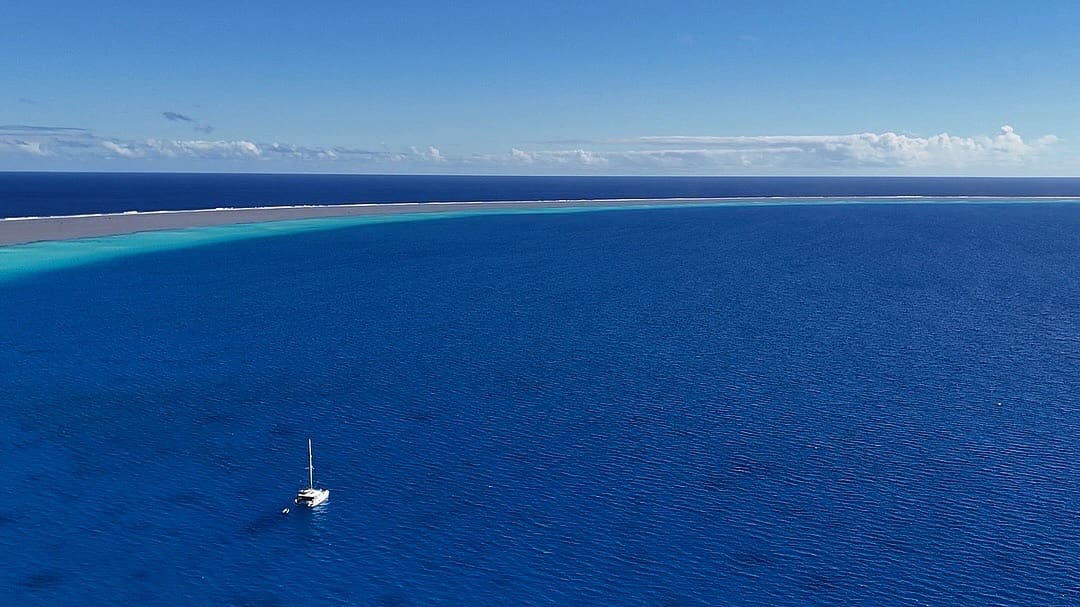
15 Responses
Whew, I need a nap now after reading this! Love you both!
We’re still recovering😴 Love you!
Such a relief having you on land after all that! Love you guys!
Agreed! Love you!
Hi – What no fruit dog? when i was entering New Zealand i got sniffed by a fruit dog. i hate fruit so i did not have any but i was sure to get a pass for the dogs mistake. i think he just knew i liked dogs.
No dog! They did look in every single cabinet and compartment, though. We would’ve loved a dog visit after that challenging passage!
i’m breathing so fast! what a an awesome experience to have behind you and not to still be in! hope things go smooth for you in NZ! 😘
Hopefully a one and done experience! 😅 So far, so good here in NZ. We miss you!
Wow perseverance has its rewards!! Congratulations and look forward to your successful refit!! You guys ROCK!!
This definitely felt like an earned accomplishment!! Thanks for cheering us on.
Congratulations and Well Done! Thanks for all the advice and info. Leave some room for PISCES…hope to see y’all in a couple months. 😎👍👍
We’ll be here, waiting for ya!
I am so proud of you two. I have been following your blogs for now 6 months. I am a par-time boater and can’t imagine how you were able to navigate this and arrive in New Zealand.
Best of luck
Dave S
Hey, Dave. Thanks for the encouragement. It’s been a long and challenging journey, but hey, that’s sailing for ya! We’re looking forward to getting Sabado set up for the next chapter of our adventure… ❤️
Hi guys,welcome to NZ ,shame about the weather it really doesn’t getting any better till December so hopefully you get to spend time on the boat here after that. Good effort on the the Tonga to NZ trip ,it is nasty even at the best time to do this leg.